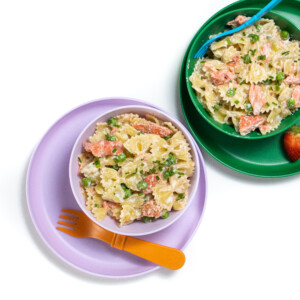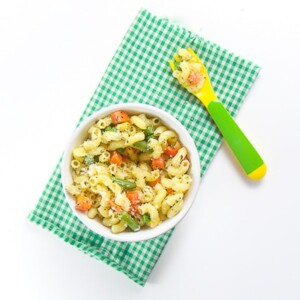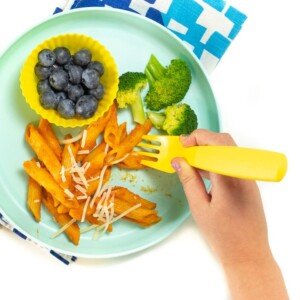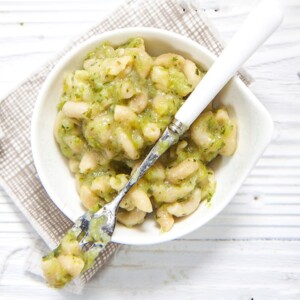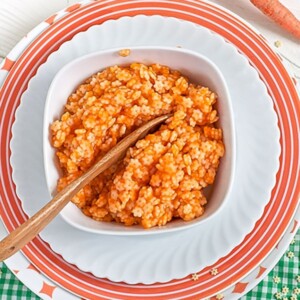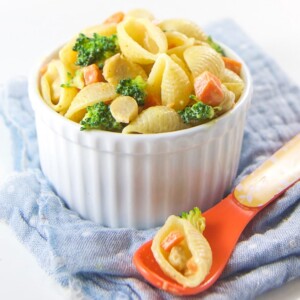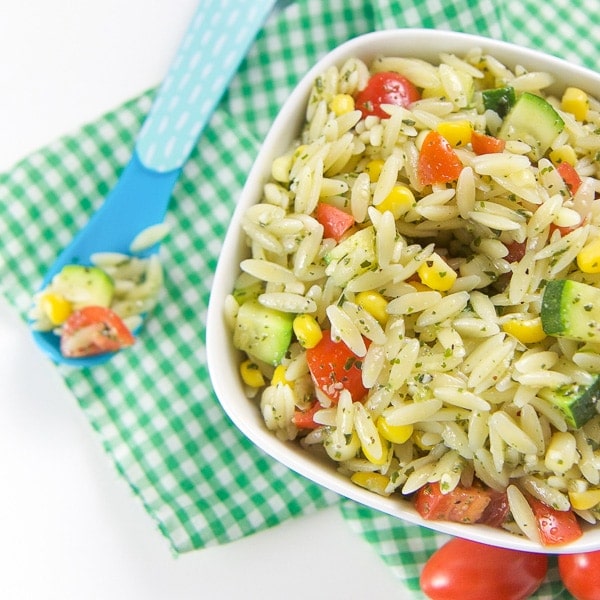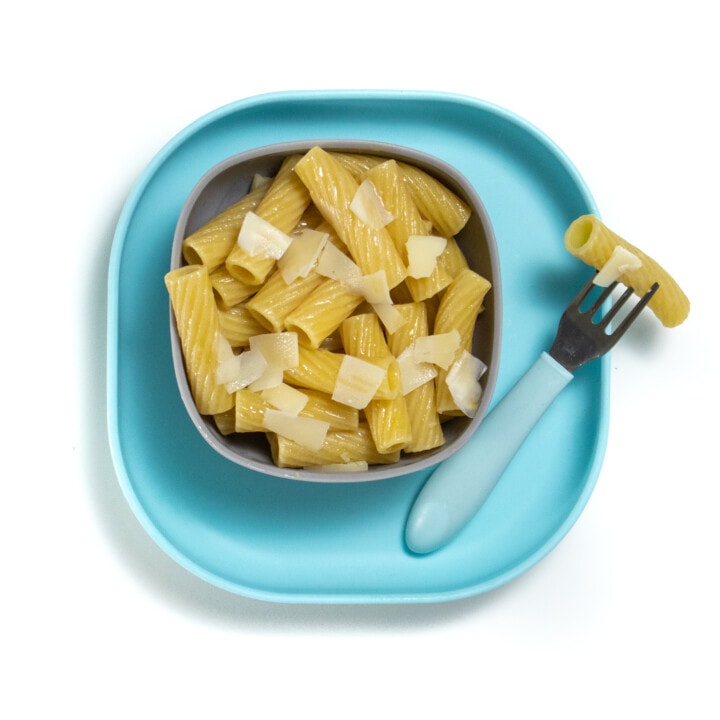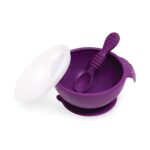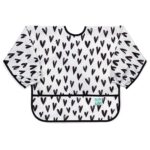How to Serve Pasta to Baby
Pasta is a great way to offer energizing carbohydrates for your baby’s development. We’ll review the health benefits, the best types of pasta for your baby, FAQs, feeding tips, and so much more! Great for baby-led weaning, the finger food stage, and stage three baby food purees! 6+ months and up.

Medically reviewed and co-written by Jamie Johnson, Registered Dietitian Nutritionist (RDN), and Lauren Braaten, Pediatric Occupational Therapist (OT).
Pasta Baby Food
Let’s face it – there’s nothing cuter than seeing a smiley, squishy baby covered from head to toe in pasta noodles and sauce (your kitchen floor, on the other hand….not so cute, but it’s washable. Maybe you should just get a dog now. Or borrow the neighbor’s dog?). Pasta is a perfect first food for your baby, and not just because of its yummy comfort food quality, although that’s a bonus.
Pasta can be a great source of iron, fiber, folate, protein, and B vitamins. It also makes for a soft finger food that is just as easy for your baby to self-feed as it is for parents to cook up in the kitchen. And when paired with protein, high-quality fat, and veggies, it makes for a well-rounded meal that will satisfy your baby AND your whole family.
First time making homemade baby food? Then, I would suggest that you start by reading my very in-depth Guide on how to Make Homemade Baby Food – which goes over all the important information such as the best cooking tools to have on hand, safe storage, how to know when baby is ready for solids, how to introduce purees, the best first foods for baby, and more! If you are doing Baby-Led Weaning, then be sure to check out my Complete Guide to Baby-Led Weaning – which covers what exactly is baby-led weaning, to every parent’s concern of baby-led weaning and choking, this guide goes over it all. I will also share how to know when baby is ready for BLW, the top 10 best first foods, a helpful sample blw feeding schedule, helpful tools to have on hand, and much much more!
Want more information? Then make sure to check out my best-selling cookbook Little Foodies: Recipes for Babies and Toddlers with Taste.
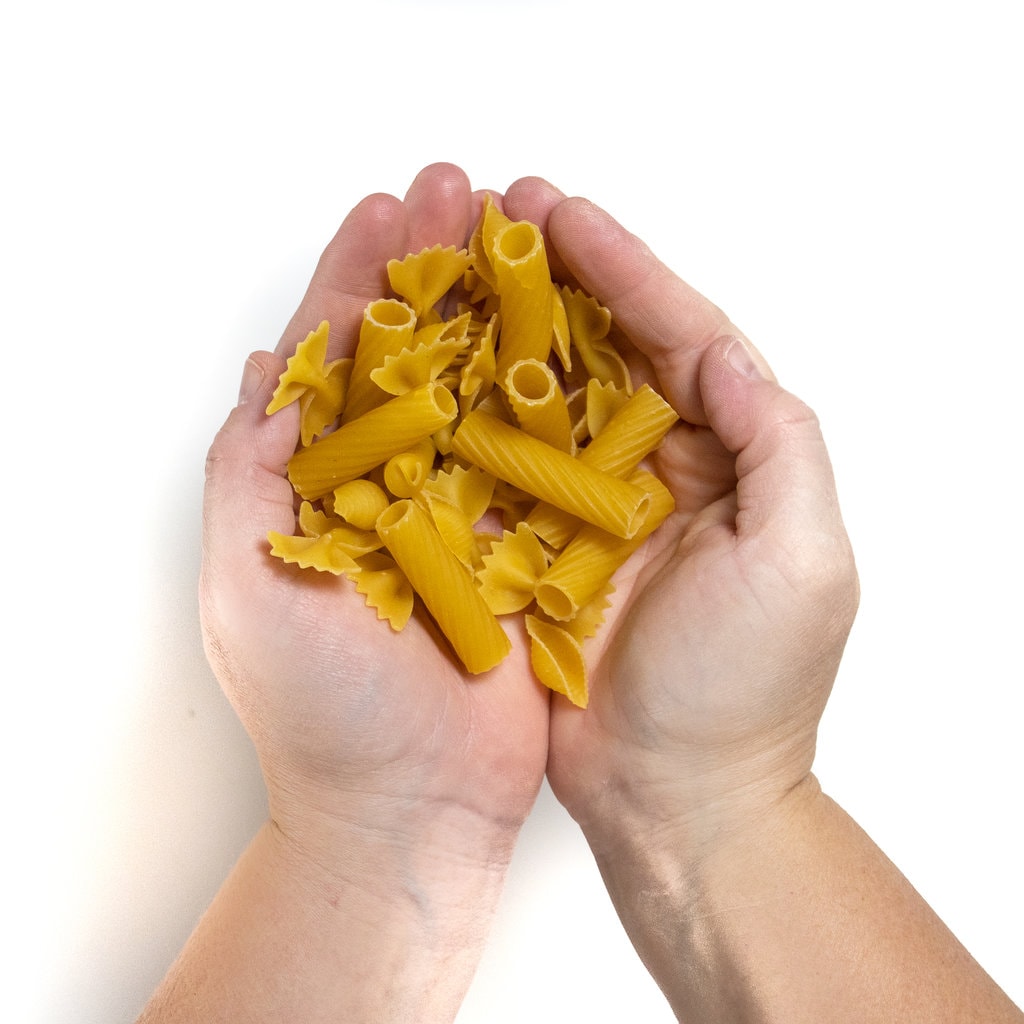
Reasons to Love Pasta for Baby
- Great for baby-led weaning or the finger food stage
- Good in a Stage 3 Baby Puree
- Provides an easily customizable base for a meal that’s family-friendly
- Great source of carbohydrates that provide energy
- Readily available and budget friendly
- Many options – including whole grain, bean-based, or gluten-free
- Perfect for pairing with a protein, veggie, and high-quality fats to make a balanced meal
Benefits of Pasta for Baby
Pasta can be a great food for your baby, for both developing oral motor skills and nourishing their bodies.
- full of carbohydrates to provide energy
- whole grain or bean-based pasta provides fiber, which helps keep their digestive systems regular
- depending on the shape, pasta can help develop pincer and palmar grasps
- a soft consistency, making it easy for your baby to chew
- there are many types of pasta that expose your baby to different tastes and textures
- can be paired with many sauces to keep meals new and exciting
- bean pastas are a good source of protein
- can be a good source of iron, which is very important for babies 6 months and up to get from their diet

Best Types of Pasta for Baby
There are so many different types of pasta on the market these days made from grains, beans, eggs, rice, and other ingredients, and they all offer different nutrients. There’s not one best pasta for your baby so try mixing it up to get a variety of textures, flavors, and nutrients. Here are some highlights of different types of pastas:
- lentil pasta: high in fiber, iron, protein, gluten-free
- black bean pasta: high in fiber, iron, protein, gluten-free
- chickpea pasta: high in fiber, iron, protein, gluten-free
- whole wheat: higher in fiber, manganese, and selenium, not gluten-free
- white flour: low fiber, higher in B vitamins and iron, not gluten-free
- egg noodles: low fiber, higher in B vitamins, iron, and manganese, not gluten-free
- rice noodles: low fiber, protein and iron, gluten-free
- edamame and mung bean pasta: high in fiber, iron, protein, potassium, gluten-free
Best Shapes of Pasta for Baby
Generally, the younger the baby, the bigger the pasta shape should be to help minimize choking and to meet their grasping skills.
- 6+ months: conchiglioni, farfalle, rigatoni, penne, ziti, lasagna noodle strips, chopped longer noodles like spaghetti, fettuccine, linguine, or capellini
- 9+ months: macaroni, cut ravioli, conchigliette, plus noodles offered at 6 months
- 12+ months: spaghetti, linguine, fettuccine, ramen, rice noodles, plus noodles offered at 6 and 9 months
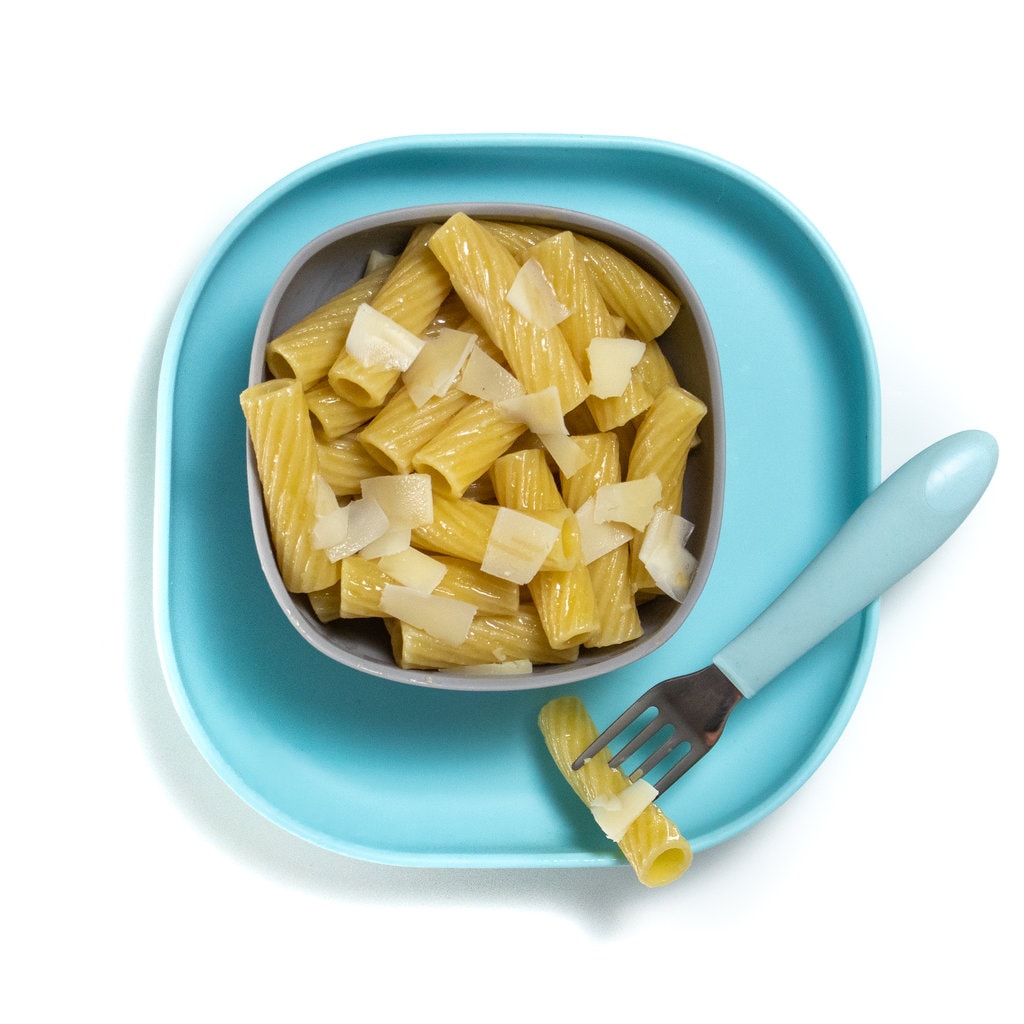
Step-by-Step Instructions
- Bring a large pot of water to a boil.
- Add in pasta and cook 1-2 past the ‘al-dente’ time on the box.
- Drain and add back to the pot.
- Add in butter, oil, pesto or other sauce of choice.
- Spoon into a bowl or onto the highchair tray and sprinkle with a pinch of cheese.
Frequently Asked Questions
You can introduce pasta when your baby shows signs of readiness, usually around 6 months. That being said, many kinds of pasta contain wheat and/or eggs which are 2 of the most common food allergens. It is recommended to wait to introduce the top eight allergen foods to your baby once a few other well-tolerated foods have been introduced, especially if your baby is at high risk for food allergies. With pasta, it might be best to introduce eggs and wheat separately before pasta to be able to identify any allergies.
Cooked pasta is not typically a choking hazard, though anyone can choke on any food, so always supervise your baby while they are eating.
Many kinds of pasta contain the common food allergens of wheat and eggs, so always read an ingredients list if your child is allergic to one of these. The good news is that there are many types of kinds of pasta on the market that do not contain these ingredients, so you should be able to find one that meets your baby’s needs. As with any food, start with a small portion and be aware of any signs that might be an allergic reaction after introducing it. If you suspect your child has food allergies, talk with your pediatrician about the best way to introduce allergens.
Too much pasta from refined grains like white flour can be constipating. However, whole-grain pasta or pasta made from beans may help relieve constipation since they are higher in fiber.
Baby Feeding Tips
- When making pasta for babies, it should be cooked fully and a little past al dente, so that it’s easily squishable. If you or the rest of your family prefers a little firmer pasta, just take out portions for them and cook the rest a little longer for your baby.
- Serve pasta with a little bit of olive oil, ghee, or sauce to make it easier to mash for beginning eaters.
- Use kitchen shears to cut noodles into smaller bite-sized pieces as needed.
- Pasta can be served on a pre-loaded fork to your baby or let your baby use their hands.
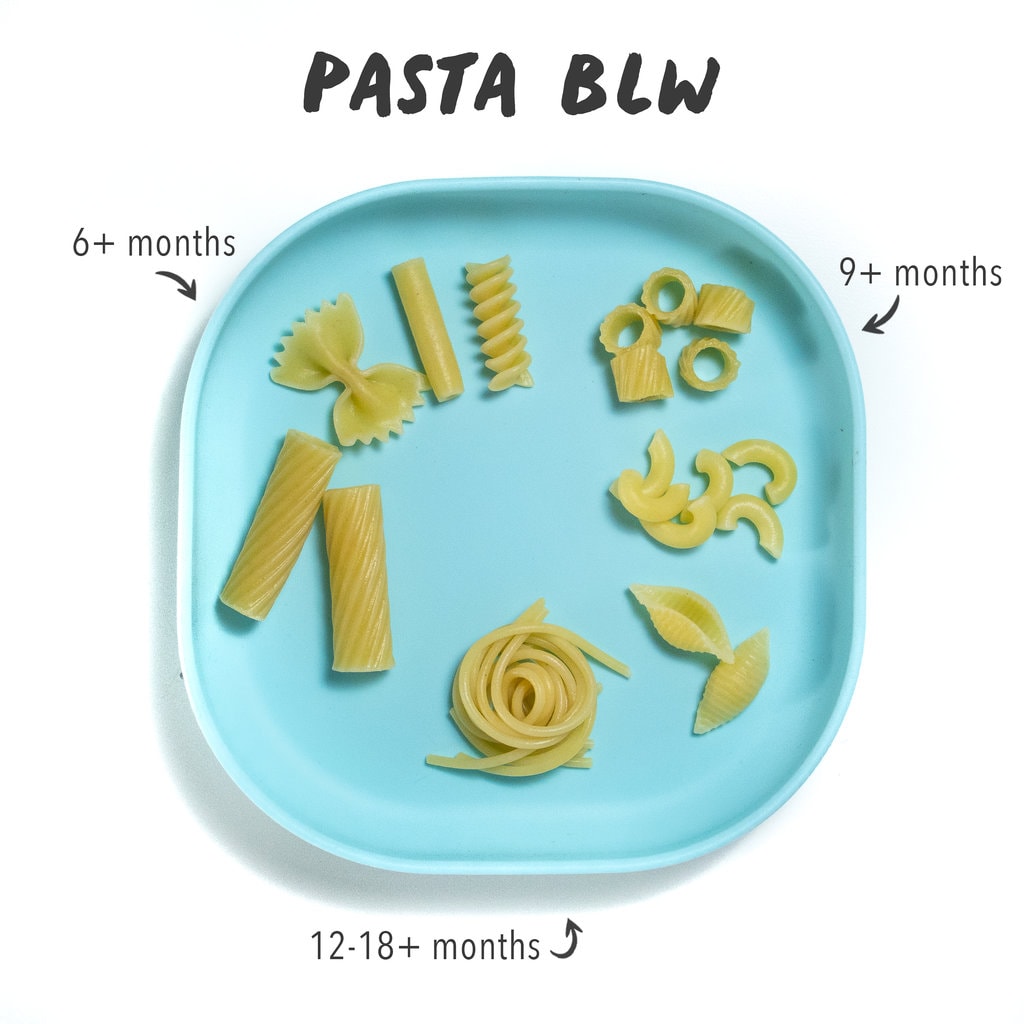
Pasta for Baby-Led Weaning
Pasta is a great food for your baby to self-feed, whether for baby-led weaning, which happens around 6 months of age, or during the finger foods stage after traditional weaning at 8-9 months.
6+ Months – Bigger Shapes: rigatoni, rotini, ziti, farfalle, lasagna noodle strips, etc. At this age, offering larger pieces of wide, flat, or tubular-shaped pasta will help your baby grasp the pasta better.
9+ Months – Smaller Shapes: elbow, ravioli, penne, rotini, bow tie, cut noodles, etc. At this age, your baby will develop a pincer grasp, where they can pick up smaller pieces of food using their thumb and index finger. You can also continue to serve larger, wider pieces of pasta if your baby is more successful with this size and shape.
12-18+ Months – Noodles: spaghetti, rice noodles, udon, ramen, etc. At this age, your toddler might be more willing to accept a pre-loaded fork with pasta on it, but it’s totally fine if they still prefer using their fingers. Continue to offer a variety of noodle shapes and textures.
Pasta for Traditional Weaning
If you started out feeding your baby using traditional weaning (aka spoon feeding), your baby will typically be ready to start trying pasta anywhere between 7-9 months (although always keep in mind that each baby is different, and your baby’s developmental progress and skills may look slightly different).
How you offer pasta at this point really depends on the individual baby. You can offer small, soft pieces of pasta and a pureed sauce together, either on a pre-loaded spoon or for your baby to self-feed with their hands. Or your baby might be ready at this point to try self-feeding bigger, wider pieces of tubular pastas, such as rigatoni, rotini, ziti, farfalle, or lasagna noodle strips.
Favorite Pasta Recipes
Salmon Pasta with Peas
Easy-Peasy 5 Veggie Pasta for Baby
Hidden Veggie Pasta Sauce
Chunky Summer Veggie Pasta
Carrot Pasta for Baby + Toddler
Baby’s First Bolognese
Curry Pasta Salad for Baby + Toddler
Summer Pesto Finger Salad for Baby + Toddler
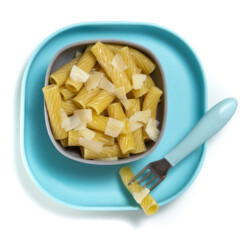
Get the recipe: How to Serve Pasta to Baby
Ingredients
- 8 oz pasta
- 1 tbsp unsalted butter or olive oil
- 1 tbsp sharp cheese (asiago, romano, fontina, gouda, etc) thinly sliced (optional)
Instructions
- Bring a large pot to a boil, add in pasta and cook according to the package. For babies just starting to eat pasta, cook the pasta 1-2 minutes more than 'al-dente' or the package direction.
- Drain, and add pasta back to large pot. Add in the butter, and melt while stirring.
- Spoon into bowls and sprinkle with cheese.
Notes
Did you make this recipe?
Tag @babyfoode on Instagram and hashtag it #babyfoode!

